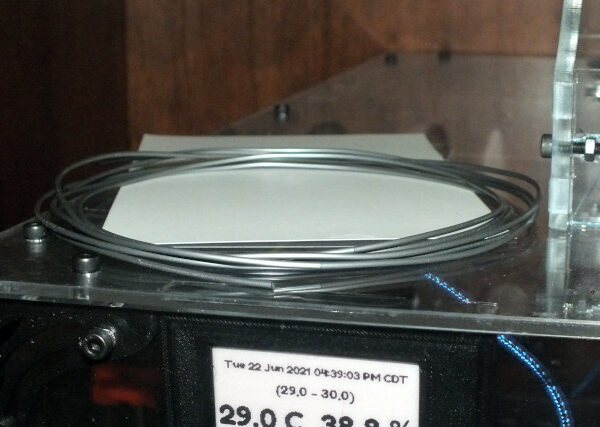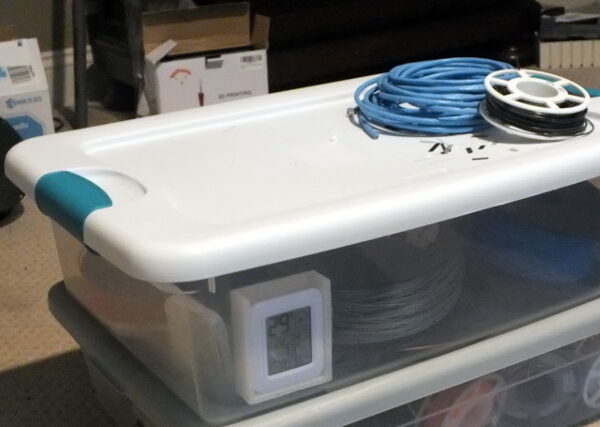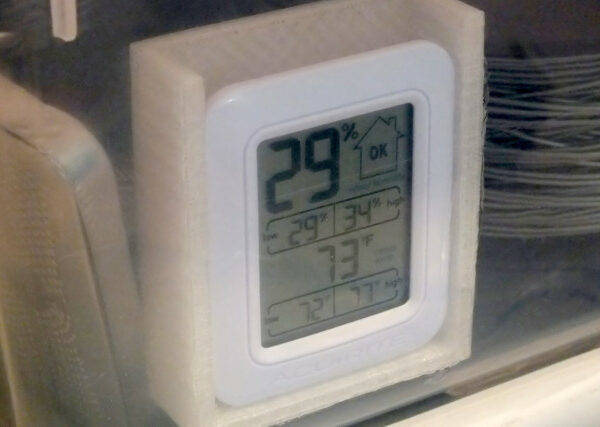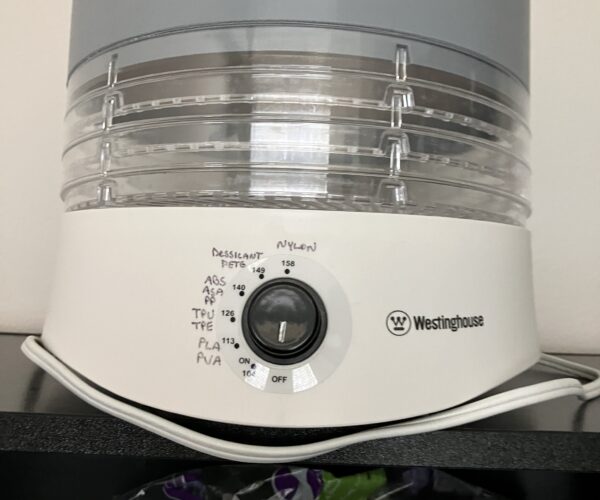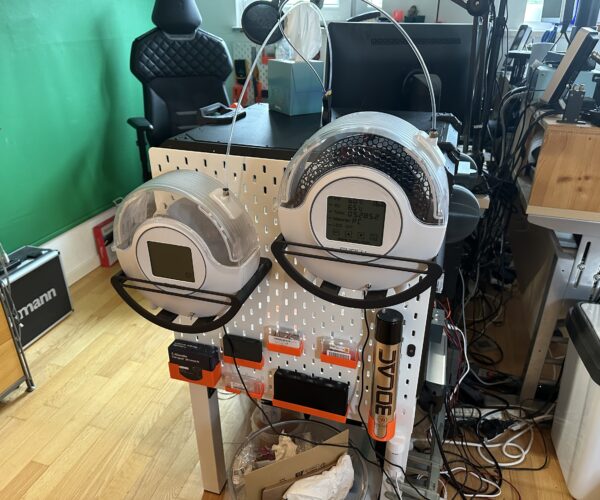RE: How do you use a filament dryer?
Yes, what you said. PLA on spools that are a bit older sometimes gets brittle and breaks into small pieces. Depends on the sort and manufacturer. But the problem can be remedied by putting the spool into the dryer for a couple of hours.
As for Nylon: I have printed the upgrade parts for my MK3S to + in eSun PAHT CF. That needed long drying time and I printed it directly from the Eibos dryer. I had no enclosure then, just used a draft shield, but the PAHT CF had far fewer problems with warping than when I tried ABS or ASA, even with a makeshift garbage bag enclosure (for ABS/ASA).
For some ballpark data Youtube style:
Thomas Sanladerer tests filament drying:
After a week exposed in a room with a dehumidifier running there was noticeable deterioration of PLA finish...
CNC Kitchen - skip to 7.40 for time to fully hydrate results.
Cheerio,
RE: How do you use a filament dryer?
Having worked in science fields, it is hard to take just random amounts for numbers and always told to look at hard numbers. Even ordered multiple cheap temp/RH% sensors to ensure that there were multiple readings to compare. As it turns out, all were within 1% for RH and 1 degree for temperature, even when compared to the monitor in my ventilation system. Now I have some for each box.
As for dryers, that is another interesting investigation. CNC Kitchen video was interesting as were reviews on methods of drying filament. As I have a vacuum system, I was looking at that as a method and CNC Kitchen has shown that it is not a good method. What I did find was a review of drying techniques and one that compared homemade to commercial dryers and food dehydrators with the homemade one winning since it is a combination dry box and dryer in one for about $20 - 30 per dry box using reptile heaters.
In my searches, I also found many different homemade dryers that are as simple as cardboard box with light bulbs and using the printer heat bed as a heat source. One was using a single board computer to control the humidity within the dryer.
As for storage of filament once dry, many showed containers of different types. I liked the 20 litre pails with desiccators with the snap on lids that you can get at some hardware stores. Most of these seal enough for liquids.
For hard numbers, in general, it came to being less than 10% is a good place to aim for. This is usually below our RH so I will be going with some version of drying sooner than later. As I was planning on boxes to keep my filament away from dust and dirt, the use of the reptile heater (silicon heating pad) method is something I will be looking at. I may modify the system to work on humidity for control instead of temperature. A homemade combination system may work better in my workshop layout than a commercial one. One step at a time.
RE: How do you use a filament dryer?
I would echo the remark that PETg seems to be a bit more sensitive to humidity in room air than does PLA. In particular, irregular surfaces on vertical pieces seems to be the give-away of damp PETg filament.
I use the Ninja Cooker, set on Dehydrate, 120F/49C for 12 hours overnight, plus I have three dry storage boxes with the dry-packs and a humidity gauge.
I have only seen one spool of filament that could not be made usable by dehydrating overnight. This was a partial spool that sat in the corner of the spare bedroom for over a year. It was the FilamentPM brand of the silver-gray PLA that's shipped (used to be shipped) with the new Prusa printers.
It would break when I attempted to print with it. Close inspection (look closely in photo) shows hairline cracks that render the filament unusable.
This was a remnant of what was respooled onto standard spools from a much larger spool, manually, and may have been wound too tightly.
RE: How do you use a filament dryer?
I don't use a filament dryer btw, I use a lightly modified food dehydrator for which I have printed extension collars so that two or three regular spools can be dried together - or just one extra large one.
RE: How do you use a filament dryer?
As I am new to 3D printing and there is much to learn, I am realizing that keeping filament dry is a more economical point than drying every time you go to use filament. Understanding how water vapour in the air changes with temperature, and thus the RH, keeping filament warmer will also keep it dryer. Just watching the RH change during a print process in the enclosure, had me questioning many comments, even though I live in a dry locations. Recent issues with starting to print with PETG had me looking into this further as nothing was working which is another story and not related to moisture.
For a set amount of water in the air, the humidity changes as the temperature fluctuates. In a cold workshop in winter you may have 15 degrees but the humidity could be as high as 50%. Heat that same air to 20 and it drops to 37. Go to 25 and it is down to 27%. Of course, higher RH makes it easier for the filament to absorb moisture. This is why a dryer needs to heat the air to remove the moisture from filament.
Did some tests the other day with solar heating and in a sealed box, the RH dropped down to less than 10% as the sun heated up the box. I think 10% is the lowest that the digital humidity sensor works to. Going to look at building a solar filament drying system for use in the summer.
With this in mind, I found an article on using a reptile heater in the "dry box" to keep the filament warm and will plan my operation around that. As well as methods of keeping filament dry while stored during winter. All of this to save headaches and eliminate one possible issue when printing.
RE:
I want to get a dryer but not sure which to go for between the following:
Eibos EasyDry - has the heating element in the centre of the spool with a fan blowing the heat through - hence it radiates around the entire spool pretty equally. Nice and easy to set temperature by using a simple labelled dial.
Sunlu S2 - no fan etc, but has heating elements around the entire spool. Fancy touch screen interface.
Both have around the same power requirements so both seem pretty efficient.
Which to go for?
RE: How do you use a filament dryer?
I would prefer the one with a fan that tells that lazy air to get busy and not just sit there at the top! 🙂
A fan will give more even drying inside the box. It is also important that the box lets the humid air escape. You can add a box with silicagel in the middle of the spool (there are models for this). But I have found that these tend to always fall out if you change the spools and don't remember the box in the middle. I let the humid air escape by opening the box a little. You can observe this with a hygrometer. In a closed box the humidity will not decrease, but if you open it a little crack the humidity will go down.
RE:
I think there are two subtopics here, as in drying filament, and keeping said dry filament dry.
I'm a numbers guy too, but when it comes to filament, it's difficult to measure how much moisture has contaminated a particular spool of filament, and I've found by trial and error that overnight (12 hours) at 120F/49C will render almost any filament perfectly printable. (See exception above.) That covers the 'getting it dry' part.
As for keeping it dry, I use makeshift dryboxes made of Home Depot storage tubs, those silica gel dry-packs, and an el-cheapo humidity gauge on the side of each one. When the humidity creeps up, I'll run the dry-packs overnight in the Ninja Cooker set on dehydrate. As you can see below, the gauge indicates that it's time for a dry-out cycle.
RE:
My sunlu S2 lasted 7 months (after about 8 uses).. and died in a way that is quite common from reports I since have heard.. .. they are poorly designed.. Also although it had a 1 yr warranty, neither Sunlu nor the Canadian vendor Digitmakers would replace totally at their cost. I bought a PrintDry Pro.. more expensive.. but has good reviews by owners here. It is one of the only ones with a fan and the newest edition goes hotter than most food dehydrators.. (if you need to dry such filament)
RE: How do you use a filament dryer?
Your setup looks very close to what I have now. My containers are large enough to have the spools vertical so they can feed the printer. Even the desiccant packs look the same.
I agree that there are two sub topics here but they do go hand in hand. Good storage removes the need for drying in most cases, lots of drying removes the need for good storage.
Due to dust issues, I will be feeding my printer from a storage box but as I now understand that low temperatures can drastically increase the humidity in the air, all that physics stuff, I will keep my filament warm using the idea of a reptile heater or silicone heating pad. I like the idea of the heating pad since the temperature can be turned up and used to assist in keeping filament dry. Only really needed in winter. Plan on testing a solar dryer idea since we get lots of sun and it is normally very dry. Supposed to be close to 30 for the next few days. A test I did the other day when it was, cooler warmed a large container to 40 degrees. Humidity dropped to 10% which I think is the bottom of the meter I was using.
My main reason for keeping filaments dry is the need to change from one to the other in a project that pops up. I have seen the mess with nylon that isn't dry at work. It was not pretty.
RE: How do you use a filament dryer?
If I had it to do over, I would most likely have used a larger container for vertical storage, mainly to get more spools in one container.
I use too many different types/colors of filament regularly to try to have all/most/some of them in self-feeding dryboxes.
RE: How do you use a filament dryer?
So true. I will have one large for feeding. May be two if I start to use 2kg spools. I have a MMU2. I have two others for storage and possibly drying as they were a 3 pack at Costco. Buying gasket material to make them more air tight.
RE: How do you use a filament dryer?
@extra-fox
Do you have an adapter for putting them on top of the printer? If so can you share this? Or do you just have a shelf?
This method sounds attractive, but I thought you needed to dry filament for a few hours before using?
RE: How do you use a filament dryer?
I do, but I designed them around a Printer-Box enclosure which is metal. So they're intended for using strong magnets with. Without magnets, I'm not sure they'd do much good.
Here's what I'm using: https://www.printables.com/model/420382-filament-dryer-magnetic-brackets
Aaron
RE: How do you use a filament dryer?
I found this chart of drying times and temps a while ago. The times are for a 1/2 KG spool. Like other posters, I find that drying overnight cures most issues. I live in a high humidity area and dry my filaments to hit approx 15% - 20% per cheap analog humidity indicators, which overnight drying does. People who live in the desert areas will have different needs than someone living in a very humid area. I do not print from a drybox, i just dry the roll after printing is done.
I put the food dehydrator in a half-bath with the exhaust fan running overnight. This gets a full day of printing (14 hours +/-) before re-drying. I seal the filament in FoodSaver bags with desiccant packs, also dried in the dehydrator during the day while printing, or for big 2Kg rolls i use a sterilite box box that has a seal and was purchased that way. The pictured box and 2KG roll of PETG filament was dried over a year ago and I pulled it out and used it without issue recently. The humidity in the box was 15 - 20% and stayed that way for over a year....
PETG starts to get little strings or hairs as the first indication of filament getting wet and that is the clue to put in dehydrator and switch to a different roll. PLA will also print better when dry and you can tell when PLA is very wet when it comes out of the extruder and pops and crackles. Pictures for reference.
Strange women, laying in ponds, distributing swords, is hardly a basis for a system of governance!
RE: How do you use a filament dryer?
There are many videos and plans on using dry boxes made out of plastic bins online. Many of the examples use 4mm OD tubing feeding out of the boxes. Many have 3D printed fittings for the tubing. There are many spool holder designs that you can use, depending on your needs. I have seen some where the bin has a holder glued on the sides for holding a wooden rod to hold the spools. Others get more complicated, up to and including auto-winding spools.
As some take the approach to dry their filament before using, I prefer to keep it dry, even though I live in a mostly dry area of the country. All my filament is stored in sealed plastic bins with activated alumina desiccant. I currently have 3 bins full of filament. None of these have feed arrangements. All the bins are below 19% RH at 19°.
My reason? I don't have to plan in advance what filament I am using or need at the time. It allows me to change priorities to what I am printing and what filament I need.
My main filament feed isn't built yet as my requirements changed and other life priorities.
RE: How do you use a filament dryer?
I personally do always print out of my dryers. Not only because of the humidity - especially when using rather brittle filaments, it helps a lot to warm the stuff up a bit. The problem of properly placing the dryers was easily resolved with FreeCAD and a few meters of Prusament PC-CF...
RE: How do you use a filament dryer?
I like the setup. I also like the clean shop. 🙂 I will be using a box due to dust and dirt. My setup is in a workshop with wood and metal work. Just dust in the air gets everywhere here.
